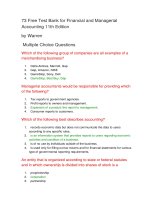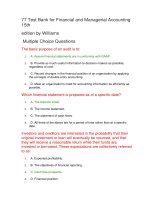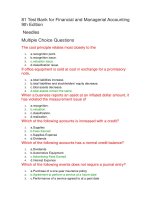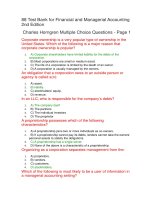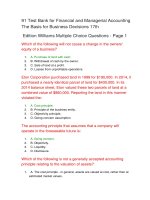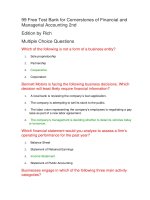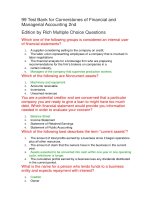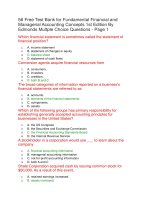Test bank financial and managerial accounting by warren 9e ch02 analyzing transactions
Bạn đang xem bản rút gọn của tài liệu. Xem và tải ngay bản đầy đủ của tài liệu tại đây (354.72 KB, 56 trang )
Chapter 2
Analyzing Transactions
OBJECTIVES
Obj 1
Obj 2
Obj 3
Obj 4
Describe the characteristics of an account and record transactions using a chart of
accounts.
Describe and illustrate the posting of journal entries to accounts.
Prepare an unadjusted trial balance and explain how it can be used to discover
errors.
Discover and correct errors in recording transactions.
QUESTION GRID
True / False
No.
1
2
3
4
5
6
7
8
9
10
11
12
13
14
15
16
17
18
19
20
21
22
23
24
25
26
27
Matching
1
Objective
02-01
02-01
02-01
02-01
02-01
02-01
02-01
02-01
02-01
02-01
02-01
02-01
02-01
02-01
02-01
02-01
02-01
02-01
02-01
02-01
02-01
02-01
02-01
02-01
02-01
02-01
02-01
2 ✦ Chapter 2/Analyzing Transactions
No.
1
2
3
Objective
02-04
02-04
02-04
Multiple Choice
No.
1
2
3
4
5
6
7
8
9
10
11
12
13
14
15
16
17
18
19
20
21
22
23
24
25
26
27
28
29
30
31
32
33
34
35
36
37
38
Exercise/Other
Objective
02-01
02-01
02-01
02-01
02-01
02-01
02-01
02-01
02-01
02-01
02-01
02-01
02-01
02-01
02-01
02-01
02-01
02-01
02-01
02-01
02-01
02-01
02-01
02-01
02-01
02-01
02-01
02-01
02-01
02-01
02-01
02-01
02-01
02-01
02-01
02-01
02-01
02-01
Chapter 2/Analyzing Transactions ✦ 3
No.
1
2
3
4
5
6
7
Problem
OD OD OD
0 M0 M0 M
0 M0 M0 E
0D 0 D 0D
0 M0 M0 D
0D 0 D
0D 0 D
Chapter 2—Analyzing Transactions
TRUE/FALSE
Objective
02-01
02-01
02-01
02-01
02-01
02-01
02-01
4 ✦ Chapter 2/Analyzing Transactions
1.
Accounts are records of increases and decreases in individual financial statement items.
ANS: T
DIF:
Easy
OBJ: 02-01
2. A chart of accounts is a listing of accounts that make up the journal.
ANS: F
DIF: Easy OBJ: 02-01
3. The chart of accounts should be the same for each business.
ANS: F
DIF: Moderate
OBJ: 02-01
4. Accounts payable are accounts that you expect will be paid to you.
ANS: F
DIF: Moderate
OBJ: 02-01
5. Consuming goods and services in the process of generating revenues results in expenses.
ANS: T
DIF: Easy OBJ: 02-01
6. Prepaid expenses are an example of an expense.
ANS: F
DIF: Moderate
OBJ: 02-01
Chapter 2/Analyzing Transactions ✦ 5
7. Unearned Revenues are an example of a liability.
ANS: T
DIF: Moderate
OBJ: 02-01
8. Dividends are an example of an expense.
ANS: F
DIF: Moderate
OBJ: 02-01
9. Accounts in the ledger are usually maintained in alphabetical order.
ANS: F
DIF: Moderate
OBJ: 02-01
10. Depending on the account title, the right side of the account is referred to as the credit side.
ANS: F
DIF: Moderate
OBJ: 02-01
11. To determine the balance in an account, always subtract credits from debits.
ANS: F
DIF: Moderate
OBJ: 02-01
12. Unless the transaction is compound, the dollar amount of the debits for each transaction is
equal to the dollar amount of the credits for that transaction, and thus the term double-entry
bookkeeping.
ANS: F
DIF: Difficult
OBJ: 02-01
13. The double-entry accounting system records each transaction twice.
ANS: F
DIF: Easy OBJ: 02-01
14. The increase side of all accounts is the normal balance.
ANS: T
DIF: Easy OBJ: 02-01
15. The journal is the book of original entry.
ANS: T
DIF: Easy OBJ: 02-01
16. The process of recording a transaction in the journal is called journalizing.
ANS: T
DIF: Easy OBJ: 02-01
17. Journalizing is the process of entering amounts in the ledger.
ANS: F
DIF: Easy OBJ: 02-01
18. Transactions are listed in the journal chronologically.
ANS: T
DIF: Moderate
OBJ: 02-01
19. Journalizing transactions using the double-entry bookkeeping system will eliminate fraud.
ANS: F
DIF: Moderate
OBJ: 02-01
20. Liability accounts are increased by debits.
ANS: F
DIF: Easy OBJ: 02-01
6 ✦ Chapter 2/Analyzing Transactions
21. Expense accounts are increased by credits.
ANS: F
DIF: Easy OBJ: 02-01
22. Revenue accounts are increased by credits.
ANS: T
DIF: Easy OBJ: 02-01
23. The normal balance of a capital stock account is a debit.
ANS: F
DIF: Easy OBJ: 02-01
24. The normal balance of the dividend account is a debit.
ANS: T
DIF: Easy OBJ: 02-01
25. The normal balance of an expense account is a credit.
ANS: F
DIF: Easy OBJ: 02-01
26. The normal balance of revenue accounts is a credit.
ANS: T
DIF: Easy OBJ: 02-01
27. Dividends decrease stockholders’ equity and are listed on the income statement as a
deduction from revenue.
ANS: F
DIF: Moderate
OBJ: 02-01
28. For a month's transactions for a typical medium-sized business, the salary expense account
is likely to have only credit entries.
ANS: F
DIF: Moderate
OBJ: 02-01
NAT: AACSB Analytic | AICPA FN-Measurement
29. For a month's transactions for a typical medium-sized business, the accounts payable
account is likely to have only credit entries.
ANS: F
DIF: Moderate
OBJ: 02-01
NAT: AACSB Analytic | AICPA FN-Measurement
30. When a business receives a bill from the utility company, no entry should be made until the
invoice is paid.
ANS: F
DIF: Moderate
OBJ: 02-01
NAT: AACSB Analytic | AICPA FN-Measurement
31. An account has three parts to it; a title, an increase side, and a decrease side.
ANS: T
DIF: Easy OBJ: 02-01
NAT: AACSB Analytic | AICPA FN-Measurement
32. The T account got its name because it resembles the letter “T”
ANS: T
DIF: Easy OBJ: 02-01
NAT: AACSB Analytic | AICPA FN-Measurement
Chapter 2/Analyzing Transactions ✦ 7
33. The right hand side of a T account is known as a debit and the left hand side is known as a
credit.
ANS: F
DIF: Easy OBJ: 02-01
NAT: AACSB Analytic | AICPA FN-Measurement
34. A debit is abbreviated as Db and a credit is abbreviated as Cr.
ANS: F
DIF: Easy OBJ: 02-01
NAT: AACSB Analytic | AICPA FN-Measurement
35. Debiting the cash account, will increase the account.
ANS: T
DIF: Easy OBJ: 02-01
NAT: AACSB Analytic | AICPA FN-Measurement
36. A credit to the cash account will increase the account.
ANS: F
DIF: Easy OBJ: 02-01
NAT: AACSB Analytic | AICPA FN-Measurement
37. The cash account will always be debited.
ANS: F
DIF: Moderate
OBJ: 02-01
NAT: AACSB Analytic | AICPA FN-Measurement
38. The recording of cash receipts to the cash account will be done by debiting the account.
ANS: T
DIF: Moderate
OBJ: 02-01
NAT: AACSB Analytic | AICPA FN-Measurement
39. The recording of cash payments to the cash account will be done by entering the amount as a
credit.
ANS: T
DIF: Moderate
OBJ: 02-01
NAT: AACSB Analytic | AICPA FN-Measurement
40. The balance of the account can be determined by adding all of the debits, adding all of the
credits, and adding the amounts together.
ANS: F
DIF: Difficult
OBJ: 02-01
NAT: AACSB Analytic | AICPA FN-Measurement
41. Assets are owned by creditors or stockholders.
ANS: F
DIF: Moderate
OBJ: 02-01
NAT: AACSB Analytic | AICPA FN-Measurement
42. Liabilities are debts owned by the business entity.
ANS: T
DIF: Easy OBJ: 02-01
NAT: AACSB Analytic | AICPA FN-Measurement
43. The accounts payable account is listed in the chart of accounts as an asset.
ANS: F
DIF: Easy OBJ: 02-01
NAT: AACSB Analytic | AICPA FN-Measurement
8 ✦ Chapter 2/Analyzing Transactions
44. A capital stock account represents the amount of investments less dividends made by the
owner.
ANS: F
DIF: Moderate
OBJ: 02-01
NAT: AACSB Analytic | AICPA FN-Measurement
45. Revenues is the difference between cash receipts and cash payments.
ANS: F
DIF: Moderate
OBJ: 02-01
NAT: AACSB Analytic | AICPA FN-Measurement
46. Expenses are assets that no longer have a value to the company.
ANS: T
DIF: Moderate
OBJ: 02-01
NAT: AACSB Analytic | AICPA FN-Measurement
47. Retained earnings will be reduced by the amount in the dividend account.
ANS: T
DIF: Moderate
OBJ: 02-01
NAT: AACSB Analytic | AICPA FN-Measurement
48. The journal includes both debit and credit accounts for each transaction.
ANS: T
DIF: Easy OBJ: 02-01
NAT: AACSB Analytic | AICPA FN-Measurement
49. A transaction that is recorded in the journal is called a journal entry.
ANS: T
DIF: Easy OBJ: 02-01
NAT: AACSB Analytic | AICPA FN-Measurement
50. Assets are increased with debits and decrease with credits.
ANS: T
DIF: Easy OBJ: 02-01
NAT: AACSB Analytic | AICPA FN-Measurement
51. Liabilities are increase with debits and decrease with credits.
ANS: T
DIF: Easy OBJ: 02-01
NAT: AACSB Analytic | AICPA FN-Measurement
52. Debits will increase Unearned Revenues and Revenues.
ANS: F
DIF: Moderate
OBJ: 02-01
NAT: AACSB Analytic | AICPA FN-Measurement
53. Recording a credit to all stockholders’ equity accounts will increase the account.
ANS: F
DIF: Difficult
OBJ: 02-01
NAT: AACSB Analytic | AICPA FN-Measurement
54. Journal entries can have more than two accounts as long as the debits equal the credits.
ANS: T
DIF: Easy OBJ: 02-01
NAT: AACSB Analytic | AICPA FN-Measurement
Chapter 2/Analyzing Transactions ✦ 9
55. Normal balances are the side that increases the account balance.
ANS: T
DIF: Easy OBJ: 02-01
NAT: AACSB Analytic | AICPA FN-Measurement
56. When an stockholder invests assets in the business, the capital account increases due to
revenue being earned.
ANS: F
DIF: Moderate
OBJ: 02-01 | 02-02
NAT: AACSB Analytic | AICPA FN-Measurement
57. When an accounts payable account is paid in cash, the stockholders' equity in the business
decreases.
ANS: F
DIF: Moderate
OBJ: 02-01 | 02-02
NAT: AACSB Analytic | AICPA FN-Measurement
58. When an account receivable is collected in cash, the total assets of the business increase.
ANS: F
DIF: Moderate
OBJ: 02-01 | 02-02
NAT: AACSB Analytic | AICPA FN-Measurement
59. The process of transferring the data from the journal to the ledger accounts is posting.
ANS: T
DIF: Easy OBJ: 02-02
NAT: AACSB Analytic | AICPA FN-Measurement
60. The post reference notation used in the ledger is the account number.
ANS: F
DIF: Easy OBJ: 02-02
NAT: AACSB Analytic | AICPA FN-Measurement
61. The post reference notation used in the journal is the page number.
ANS: F
DIF: Easy OBJ: 02-02
NAT: AACSB Analytic | AICPA FN-Measurement
62. A notation in the post reference column of the general journal indicates that the amount has
been posted to the ledger.
ANS: T
DIF: Moderate
OBJ: 02-02
NAT: AACSB Analytic | AICPA FN-Measurement
63. The order of the flow of accounting data is (1) record in the ledger, (2) record in the journal,
(3) prepare the financial statements.
ANS: F
DIF: Moderate
OBJ: 02-02
NAT: AACSB Analytic | AICPA FN-Measurement
64. The process of transferring the debits and credits from the journal entries to the accounts is
known as “updating the accounts”.
ANS: F
DIF: Moderate
OBJ: 02-02
NAT: AACSB Analytic | AICPA FN-Measurement
10 ✦ Chapter 2/Analyzing Transactions
65. Businesses may use several special journals in their accounting systems.
ANS: T
DIF: Moderate
OBJ: 02-02
NAT: AACSB Analytic | AICPA FN-Measurement
66. Once journal entries are posted to accounts, each account will show a new balance after each
entry.
ANS: T
DIF: Moderate
OBJ: 02-02
NAT: AACSB Analytic | AICPA FN-Measurement
67. A group of related accounts that make up a complete unit is called a trial balance.
ANS: F
DIF: Easy OBJ: 02-03
NAT: AACSB Analytic | AICPA FN-Measurement
68. A trial balance determines the accuracy of the numbers.
ANS: F
DIF: Difficult
OBJ: 02-03
NAT: AACSB Analytic | AICPA FN-Measurement
69. Even when a trial balance is in balance, there may be errors in the individual accounts.
ANS: T
DIF: Moderate
OBJ: 02-03
NAT: AACSB Analytic | AICPA FN-Measurement
70. The totals at the bottom of the trial balance and the totals at the bottom of the balance sheet
both show equality and balancing, and therefore should be equal.
ANS: F
DIF: Difficult
OBJ: 02-03
NAT: AACSB Analytic | AICPA FN-Measurement
71. A proof of the equality of debits and credits in the ledger at the end of an accounting period
is called a balance sheet.
ANS: F
DIF: Moderate
OBJ: 02-03
NAT: AACSB Analytic | AICPA FN-Measurement
72. If the trial balance is in balance, it can be assumed that all journal entries were posted
corrected and no errors were made.
ANS: F
DIF: Moderate
OBJ: 02-03
NAT: AACSB Analytic | AICPA FN-Measurement
73. Posting a part of a transaction to the wrong account will cause the trial balance totals to be
unequal.
ANS: F
DIF: Difficult
OBJ: 02-03 | 02-04
NAT: AACSB Analytic | AICPA FN-Measurement
74. The erroneous arrangement of digits, such as writing $45 as $54, is called a slide.
ANS: F
DIF: Moderate
OBJ: 02-04
NAT: AACSB Analytic | AICPA FN-Measurement
Chapter 2/Analyzing Transactions ✦ 11
75. Journalizing a transaction with both the debit and the credit for $69 instead of $96 will cause
the trial balance to be out of balance.
ANS: F
DIF: Moderate
OBJ: 02-04
NAT: AACSB Analytic | AICPA FN-Measurement
76. Posting a transaction twice will cause the trial balance totals to be equal.
ANS: T
DIF: Moderate
OBJ: 02-04
NAT: AACSB Analytic | AICPA FN-Measurement
77. The erroneous moving of an entire number one or more spaces to the right or left, such as
writing $75 as $750, is called a transposition.
ANS: F
DIF: Moderate
OBJ: 02-04
NAT: AACSB Analytic | AICPA FN-Measurement
78. The materiality concept implies that if an error is large enough or could effect the decisions
of its users, a correction is absolutely necessary.
ANS: T
DIF: Difficult
OBJ: 02-04
NAT: AACSB Analytic | AICPA FN-Measurement
79. A correction entry is required for all errors that are discovered.
ANS: F
DIF: Moderate
OBJ: 02-04
NAT: AACSB Analytic | AICPA FN-Measurement
MATCHING
Several types of errors can be made during the journalizing and posting process. Match the
following with their best description.
a. Trial balance preparation errors
b. Account balance errors
c. Posting errors
1.
2.
3.
4.
5.
Balance incorrectly computed.
Debit or credit posting omitted.
Wrong amount posted to an account.
Column incorrectly added.
Balance entered in wrong column of
account.
6.
7.
8.
Amount incorrectly entered on trial
balance.
Balance entered in wrong column or
omitted.
Debit posted as credit, or vice versa.
1. ANS:
B
DIF: Difficult
OBJ: 02-04
NAT: AACSB Analytic | AICPA FN-Measurement
2. ANS:
C
DIF: Difficult
OBJ: 02-04
NAT: AACSB Analytic | AICPA FN-Measurement
3. ANS:
C
DIF: Difficult
OBJ: 02-04
NAT: AACSB Analytic | AICPA FN-Measurement
12 ✦ Chapter 2/Analyzing Transactions
4. ANS:
A
DIF: Difficult
OBJ: 02-04
NAT: AACSB Analytic | AICPA FN-Measurement
5. ANS:
B
DIF: Difficult
OBJ: 02-04
NAT: AACSB Analytic | AICPA FN-Measurement
6. ANS:
A
DIF: Difficult
OBJ: 02-04
NAT: AACSB Analytic | AICPA FN-Measurement
7. ANS:
A
DIF: Difficult
OBJ: 02-04
NAT: AACSB Analytic | AICPA FN-Measurement
8. ANS:
C
DIF: Difficult
OBJ: 02-04
NAT: AACSB Analytic | AICPA FN-Measurement
Chapter 2/Analyzing Transactions ✦ 13
MULTIPLE CHOICE
1.
Accounts
a. do not reflect money amounts
b. are not used by entities that manufacture products
c. are records of increases and decreases in individual financial statement items
d. are only used by large entities with many transactions
ANS: C
DIF: Easy OBJ: 02-01
2.
A group of related accounts that comprise a complete unit is called a
a. journal
b. liability
c. ledger
d. transaction
ANS: C
DIF: Easy OBJ: 02-01
3.
Accounts are classified in the ledger
a. chronologically
b. alphabetically
c. in accordance with their appearance in the financial statements
d. so that accounts used most often are listed first
ANS: C
DIF: Moderate
OBJ: 02-01
4.
Revenue should be recognized when
a. cash is received
b. the service is performed
14 ✦ Chapter 2/Analyzing Transactions
c. the customer places an order
d. the customer charges an order
ANS: B
DIF: Moderate
OBJ: 02-01
5.
Which of the following accounts is an stockholders' equity account?
a. Cash
b. Accounts Payable
c. Prepaid Insurance
d. Retained Earnings
ANS: D
DIF: Easy OBJ: 02-01
6.
The gross increases in stockholders' equity attributable to business activities are called
a. assets
b. liabilities
c. revenues
d. net income
ANS: C
DIF: Easy OBJ: 02-01
7.
A chart of accounts is
a. the same as a balance sheet
b. usually a listing of accounts in alphabetical order
c. usually a listing of accounts in financial statement order
d. used in place of a ledger
ANS: C
DIF: Moderate
OBJ: 02-01
8.
The debit side of an account
a. depends on whether the account is an asset, liability or stockholders' equity
b. can be either side of the account depending on how the accountant set up the system
c. is the right side of the account
d. is the left side of the account
ANS: D
DIF: Moderate
OBJ: 02-01
9.
An account is said to have a debit balance if
a. the amount of the debits exceeds the amount of the credits
b. there are more entries on the debit side than on the credit side
c. its normal balance is debit without regard to the amounts or number of entries on the
debit side
d. the first entry of the accounting period was posted on the debit side
ANS: A
DIF: Difficult
OBJ: 02-01
10. Which statement(s) concerning cash is (are) true?
a. cash will always have more debits than credits
b. cash will never have a credit balance
Chapter 2/Analyzing Transactions ✦ 15
c. cash is increased by debiting
d. all of the above
ANS: C
DIF: Moderate
OBJ: 02-01
11. A debit may signify a(n)
a. decrease in asset accounts
b. decrease in liability accounts
c. increase in the capital stock account
d. decrease in the dividend account
ANS: B
DIF: Moderate
OBJ: 02-01
12. Which of the following types of accounts have a normal credit balance?
a. assets and liabilities
b. liabilities and expenses
c. revenues and liabilities
d. capital stock and dividends
ANS: C
DIF: Easy OBJ: 02-01
13. Which of the following groups of accounts have a normal debit balance?
a. revenues, liabilities, stockholders’ equity
b. stockholders’ equity, assets
c. liabilities, expenses
d. assets, expenses
ANS: D
DIF: Easy OBJ: 02-01
14. Which one of the statements below is not a purpose for the journal?
a. to show increases and decreases in accounts
b. to show a chronological order by date
c. to show a complete transaction in one place
d. to help locate errors
ANS: A
DIF: Moderate
OBJ: 02-01
15. A credit signifies a decrease in
a. dividends
b. liabilities
c. capital stock
d. revenue
ANS: A
DIF: Moderate
OBJ: 02-01
16. A credit may signify a
a. decrease in assets
b. decrease in liabilities
16 ✦ Chapter 2/Analyzing Transactions
c. decrease in capital stock
d. decrease in revenue
ANS: A
DIF: Moderate
OBJ: 02-01
17. A debit signifies a decrease in
a. assets
b. expenses
c. dividends
d. revenues
ANS: D
DIF: Moderate
OBJ: 02-01
18. Which of the following applications of the rules of debit and credit is true?
a. decrease Prepaid Insurance with a credit and the normal balance is a credit
b. increase Accounts Payable with a credit and the normal balance is a debit
c. increase Supplies Expense with a debit and the normal balance is a debit
d. decrease Cash with a debit and the normal balance is a credit
ANS: C
DIF: Difficult
OBJ: 02-01
19. Which of the following describes the classification and normal balance of the fees earned
account?
a. asset, credit
b. liability, credit
c. stockholders' equity, debit
d. revenue, credit
ANS: D
DIF: Easy OBJ: 02-01
20. The classification and normal balance of the accounts payable account is
a. an asset with a credit balance
b. a liability with a credit balance
c. stockholders' equity with a credit balance
d. revenue with a credit balance
ANS: B
DIF: Easy OBJ: 02-01
21. The classification and normal balance of the dividends account is
a. an expense with a credit balance
b. an expense with a debit balance
c. a liability with a credit balance
d. stockholders' equity with a debit balance
ANS: D
DIF: Easy OBJ: 02-01
22. The classification and normal balance of the supplies expense account is a(n)
a. asset with a debit balance
b. asset with a credit balance
Chapter 2/Analyzing Transactions ✦ 17
c. expense with a debit balance
d. liability with a credit balance
ANS: C
DIF: Easy OBJ: 02-01
23. In which of the following types of accounts are increases recorded by debits?
a. assets, liabilities
b. dividends, liabilities
c. expenses, liabilities
d. assets, expenses
ANS: D
DIF: Easy OBJ: 02-01
24. In which of the following types of accounts are increases recorded by credits?
a. revenues, liabilities
b. dividends, assets
c. liabilities, dividends
d. expenses, liabilities
ANS: A
DIF: Easy OBJ: 02-01
25. In which of the following types of accounts are decreases recorded by debits?
a. assets
b. revenues
c. expenses
d. dividends
ANS: B
DIF: Easy OBJ: 02-01
26. In which of the following types of accounts are decreases recorded by credits?
a. liabilities
b. capital stock
c. dividends
d. revenues
ANS: C
DIF: Easy OBJ: 02-01
27. A credit balance in which of the following accounts would indicate a likely error?
a. Fees Earned
b. Salary Expense
c. Capital Stock
d. Accounts Payable
ANS: B
DIF: Difficult
OBJ: 02-01
28. A debit balance in which of the following accounts would indicate a likely error?
a. Salaries Expense
b. Notes Payable
18 ✦ Chapter 2/Analyzing Transactions
c. Dividends
d. Supplies
ANS: B
DIF:
Difficult
OBJ: 02-01
29. Randomly listed below are the steps in the accounting cycle:
(1)
(2)
(3)
(4)
prepare the financial statements
post the journal entries to the ledger
record journal entries
prepare a trial balance
What is the proper order of these steps?
a. (3), (2), (4), (1)
b. (2), (3), (4), (1)
c. (3), (2), (1), (4)
d. (4), (3), (2), (1)
ANS: A
DIF: Moderate
OBJ: 02-01
30. Which of the following entries records the payment of an account payable?
a. debit Cash; credit Accounts Payable
b. debit Accounts Receivable; credit Cash
c. debit Cash; credit Supplies Expense
d. debit Accounts Payable; credit Cash
ANS: D
DIF: Difficult
OBJ: 02-01
31. Which of the following entries records the investment of cash by Tito to the Tito
Corporation in exchange for capital stock?
a. debit Capital Stock; credit Accounts Receivable
b. debit Cash; credit Capital Stock
c. debit Dividends; credit Cash
d. debit Cash; credit Dividends
ANS: B
DIF: Moderate
OBJ: 02-01
32. Which of the following entries records the receipt of a utility bill from the water company?
a. debit Utilities Expense; credit Accounts Payable
b. debit Utilities Payable; credit Accounts Receivable
c. debit Accounts Payable; credit Cash
d. debit Accounts Payable; credit Utilities Payable
ANS: A
DIF: Difficult
OBJ: 02-01
33. Which of the following entries records the cash payment by Joe’s Care, Inc.?
a. debit Capital Stock; credit Cash
b. debit Dividends; credit Cash
Chapter 2/Analyzing Transactions ✦ 19
c. debit Salaries Expense; credit Cash
d. debit Salaries Expense; credit Salaries Payable
ANS: B
DIF: Difficult
OBJ: 02-01
34. Office supplies were sold by J's Appliance Repair at cost to another repair shop, with cash
received. Which of the following entries for J's Appliance Repair records this transaction?
a. Office Supplies, debit; Cash, credit
b. Office Supplies, debit; Accounts Payable, credit
c. Cash, debit; Office Supplies, credit
d. Accounts Payable, debit; Office Supplies, credit
ANS: C
DIF: Difficult
OBJ: 02-01
35. Office supplies purchased by J's Appliance Repair on account were returned. Which of the
following entries for J's Appliance Repair records this transaction?
a. Cash, debit; Office Supplies, credit
b. Office Supplies, debit; Accounts Receivable, credit
c. Accounts Payable, debit; Office Supplies, credit
d. Office Supplies, debit; Accounts Payable, credit
ANS: C
DIF: Difficult
OBJ: 02-01
36. Cash was paid by J's Appliance Repair to creditors on account. Which of the following
entries for J's records this transaction?
a. Cash, debit; Capital Stock, credit
b. Accounts Payable, debit; Cash, credit
c. Accounts Receivable, debit; Cash, credit
d. Accounts Payable, debit; Account Receivable, credit
ANS: B
DIF: Difficult
OBJ: 02-01
37. The process of initially recording a business transaction is called
a. trial balancing
b. posting
c. journalizing
d. balancing
ANS: C
DIF: Easy OBJ: 02-01
38. Which of the following entries records the acquisition of office supplies on account?
a. Office Supplies, debit; Cash, credit
b. Cash, debit; Office Supplies, credit
c. Office Supplies, debit; Accounts Payable, credit
d. Accounts Receivable, debit; Office Supplies, credit
ANS: C
DIF: Moderate
OBJ: 02-01
39. Which of the following entries records the acquisition of equipment on account?
a. Equipment, debit; Accounts Payable, credit
b. Equipment, debit; Cash, credit
20 ✦ Chapter 2/Analyzing Transactions
c. Accounts Payable, debit; Equipment, credit
d. Accounts Payable, debit; Notes Payable, credit
ANS: A
DIF: Moderate
OBJ: 02-01
40. Which of the following entries records the payment of rent for the current month?
a. Cash, debit; Rent Expense, credit
b. Rent Expense, debit; Cash, credit
c. Rent Expense, debit; Accounts Receivable, credit
d. Accounts Payable, debit; Rent Expense, credit
ANS: B
DIF: Moderate
OBJ: 02-01
41. Which of the following entries records the receipt of cash from patients on account?
a. Accounts Payable, debit; Fees Earned, credit
b. Accounts Receivable, debit; Fees Earned, credit
c. Accounts Receivable, debit; Cash, credit
d. Cash, debit; Accounts Receivable, credit
ANS: D
DIF: Moderate
OBJ: 02-01
42. Which of the following entries records the billing of patients for services performed?
a. Accounts Receivable, debit; Fees Earned, credit
b. Accounts Payable, debit; Cash, credit
c. Fees Earned, debit; Accounts Receivable, credit
d. Fees Earned, debit; Cash, credit
ANS: A
DIF: Moderate
OBJ: 02-01
43. Which of the following entries records the collection of cash from cash customers?
a. Fees Earned, debit; Cash, credit
b. Fees Earned, debit; Accounts Receivable, credit
c. Cash, debit; Fees Earned, credit
d. Accounts Receivable, debit; Fees Earned, credit
ANS: C
DIF: Moderate
OBJ: 02-01
44. Which of the following entries records the receipt of cash for two months' rent? The cash
was received in advance of providing the service.
a. Prepaid Rent, debit; Rent Revenue, credit.
b. Cash, debit; Unearned Rent, credit.
c. Cash, debit; Prepaid Rent, credit.
d. Cash, debit; Rent Expense credit.
ANS: B
DIF: Difficult
OBJ: 02-01
45. A patient has a physical examination and asks the bookkeeper to mail the bill. The
bookkeeper should
a. make no entry until the cash is received
b. Cash, debit; Accounts Receivable, credit
Chapter 2/Analyzing Transactions ✦ 21
c. Cash, debit; Fees Earned, credit
d. Accounts Receivable, debit; Fees Earned, credit
ANS: D
DIF: Difficult
OBJ: 02-01
46. Proof that the dollar amount of the debits equals the dollar amount of the credits in the
ledger means
a. all of the information from the journal was correctly transferred to the ledger
b. all accounts have their correct balances in the ledger
c. only the journal is accurate; the ledger may be incorrect
d. only that the debit dollar amounts equal the credit dollar amounts
ANS: D
DIF: Difficult
OBJ: 02-01
47. Which of the following is true about a T-Account?
a. Left hand side of the T-Account is called a debit.
b. Left hand side of the T-Accounts is called a credit
c. Right hand side of the T-Account is called a debit
d. None are true.
ANS: A
DIF: Easy OBJ: 02-01
48. Which of the following abbreviations are correct?
a. Debit “Dr”, Credit “Cd”
b. Debit “Db”, Credit “Cr”
c. Debit “Db”, Credit “Cd”
d. Debit “Dr”, Credit “Cr”
ANS: D
DIF: Moderate
OBJ: 02-01
49. When amounts of a transaction are entered on the left side of an account, they are said to be
a. credited
b. summarized
c. totaled
d. debited
ANS: D
DIF: Moderate
OBJ: 02-01
50. When amounts of a transactions are entered in an account on the right hand side, they are
said to be
a. credited
b. debited
c. added
d. subtracted
ANS: A
DIF: Moderate
OBJ: 02-01
51. Which side of the account increases a cash account?
a. credit
b. neither a debit or a credit
22 ✦ Chapter 2/Analyzing Transactions
c. debit
d. either a debit or a credit
ANS: C
DIF: Moderate
OBJ: 02-01
52. A cash payment is recorded on the cash account as a
a. neither a debit or a credit
b. credit
c. debit
d. either a debit or a credit
ANS: B
DIF: Moderate
OBJ: 02-01
53. The balance of the account is determined by
a. adding all of the debits to all of the credits.
b. always subtracting the debits from the credits.
c. always subtracting all of the credits from the debit.
d. adding all of the debits, adding all of the credits, and then subtracting the smaller sum
from the larger sum.
ANS: D
DIF: Difficult
OBJ: 02-01
54. A list of the accounts is called
a. ledger
b. chart of accounts
c. T-Account
d. Debit
ANS: B
DIF: Easy OBJ: 02-01
55. On the chart of accounts, the balance sheet accounts are normally listed in the following
order
a. liabilities, assets, stockholders’ equity
b. assets, liabilities, stockholders’ equity
c. stockholders’ equity, assets, liabilities
d. assets, stockholders’ equity, liabilities
ANS: B
DIF: Moderate
OBJ: 02-01
56. In which order are the accounts listed in the chart of accounts?
a. assets, expenses, liabilities, stockholders’ equity, revenues
b. stockholders’ equity, assets, liabilities, revenues, expenses
c. assets, liabilities, stockholders’ equity, revenues, expenses
d. assets, liabilities, revenues, expenses, stockholders’ equity
ANS: C
DIF: Easy OBJ: 02-01
57. Which are the parts of the T account?
a. title, date, total
b. date, debit side, credit side
Chapter 2/Analyzing Transactions ✦ 23
c. title, debit side, credit side
d. title, debit side, total
ANS: C
DIF: Moderate
OBJ: 02-01
58. Which of the following is not a correct rule of debits and credits?
a. assets, expenses and dividends are increased by debits
b. assets are decreased by credits and have a normal debit balance
c. liabilities, revenues and stockholders’ equity are increased by credits
d. the normal balance for revenues and expenses is a credit
ANS: D
DIF: Difficult
OBJ: 02-01
59. XYZ Hospital purchased X-ray equipment for $3,000, paid $750 down, with the remainder
to be paid later. The correct entry would be
a. Equipment
750
Cash
750
b. Cash
750
Accounts Payable
2,250
Equipment
3,000
c. Equipment Expense 3,000
Accounts Payable
750
Cash
2,250
d. Equipment
3,000
Accounts Payable
2,250
Cash
750
e. Cash
750
Equipment
750
ANS: D
DIF: Moderate
OBJ: 02-01
60. The chart of accounts is designed to
a. alphabetized the accounts to make reading easier for its financial statement users.
b. analyze the accounts and organize them in order of dollar amount to simplify the
accounting information for users.
c. summarize the transactions and determine their ending balances.
d. meet the information needs of a company and other financial statement users.
ANS: D
DIF: Difficult
OBJ: 02-01
61. Which of the following group of accounts are all assets?
a. Cash, Accounts Payable, Buildings
b. Accounts Receivable, Revenue, Cash
c. Prepaid Expenses, Buildings, Patents
d. Unearned Revenues, Prepaid Expenses, Cash
ANS: C
DIF: Moderate
OBJ: 02-01
62. Of the following which is true about assets
24 ✦ Chapter 2/Analyzing Transactions
a.
b.
c.
d.
ANS:
Assets include physical and intangible assets.
Assets include only physical assets.
Assets are owned solely by the stockholders of the company
Assets are the result of selling products or services to customers.
A
DIF: Difficult
OBJ: 02-01
63. Which of the following is not considered to be a liability?
a. Wages Payable
b. Accounts Receivable
c. Unearned Revenues
d. Accounts Payable
ANS: B
DIF: Moderate
OBJ: 02-01
64. Which of the following statements is not true about liabilities?
a. Liabilities are debts owned to outsiders.
b. Account titles of liabilities often include the term “payable”.
c. Cash received before services are performed are considered to be liabilities.
d. Liabilities do not include wages owed to employees of the company.
ANS: D
DIF: Difficult
OBJ: 02-01
65. The stockholders’ equity will be reduced by all of the following accounts except:
a. Revenues
b. Expenses
c. Dividends
d. All are true.
ANS: A
DIF: Moderate
OBJ: 02-01
66. Expenses can best be defined as
a. assets with no future value to the company.
b. services that have been consumed in the process of generating revenues.
c. costs that have been incurred during the course of business.
d. all are true.
ANS: A
DIF: Difficult
OBJ: 02-01
67. The chart of accounts classify the accounts to make identification of the accounts easier.
This is done by way of assigning a number to each account. The first number identifies the
classification of the type of account. Which of the following indicates the use of this
classification?
a. 1-Assets, 2-Liabilities, 3-Stockholders’ Equity, 4-Expenses, 5-Revenues
b. 1-Assets, 2-Liabilities, 3-Stockholders’ Equity, 4-Revenues, 5-Expenses
c. 1-Assets, 2-Stockholders’ Equity, 3-Revenues, 4-Expenses, 5-Dividends
d. 1-Stockholders’ Equity, 2-Dividends, 3-Revenues, 4-Expenses
ANS: B
DIF: Difficult
OBJ: 02-01
68. The ____ is where a transaction can first be found on the accounting records.
Chapter 2/Analyzing Transactions ✦ 25
a.
b.
c.
d.
ANS:
chart of accounts
income statement
balance sheet
journal
D
DIF: Easy
OBJ: 02-01
69. The process of recording a transaction in the journal is called
a. recording
b. journalizing
c. posting
d. summarizing
ANS: B
DIF: Easy OBJ: 02-01
70. Joe Brown invests $10,000 into his new business in exchange for capital stock. How would
the journal entry for this transaction be entered in the journal?
a. Cash
10,000
Capital stock
10,000
Invested cash in business
b. Cash
10,000
Capital stock
10,000
Invested cash in business
c. Capital stock
10,000
Cash
10,000
Invested cash in business
d. Capital stock
10,000
Cash
10,000
Invested cash in business
ANS: A
DIF: Moderate
OBJ: 02-01
71.
June
23 Cash
Capital stock
Invest cash in Able, Co.
6,000
6,000
The journal entry will:
a. Increase Capital stock and decrease Cash
b. Increase Cash and decrease Capital stock
c. Increase Cash and increase Capital stock
d. Decrease Cash and decrease Capital stock
ANS: C
DIF: Moderate
OBJ: 02-01
72.
June
24 Land
Cash
Purchased land for business
15,000
15,000
